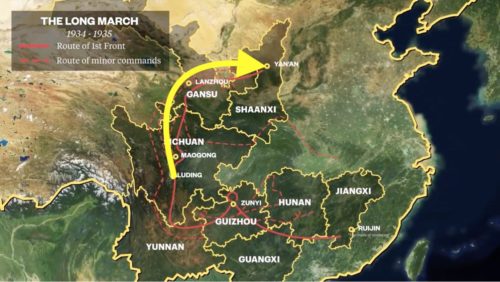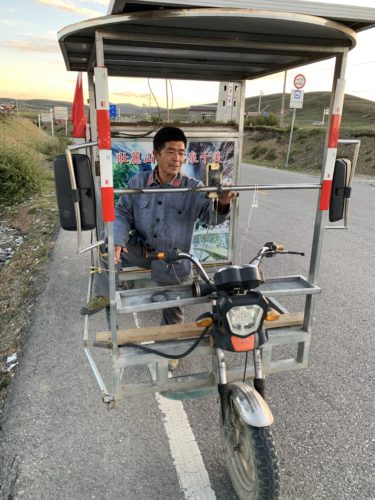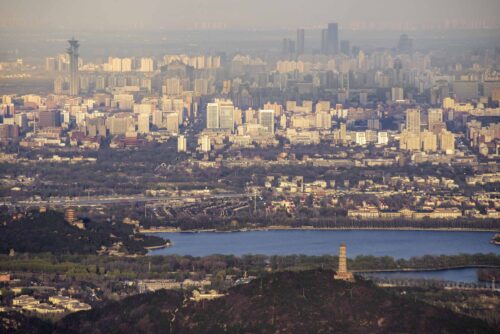Retracing the Long March: Arriving at the revolutionary capital
In this final part of a three-part dispatch, Mads Vesterager Nielsen arrives at the revolutionary capital of Yan’an, Shaanxi province, to conclude a 6,500-kilometer trip. Along the way, he encounters flooded roads, livestreamers, and priests.
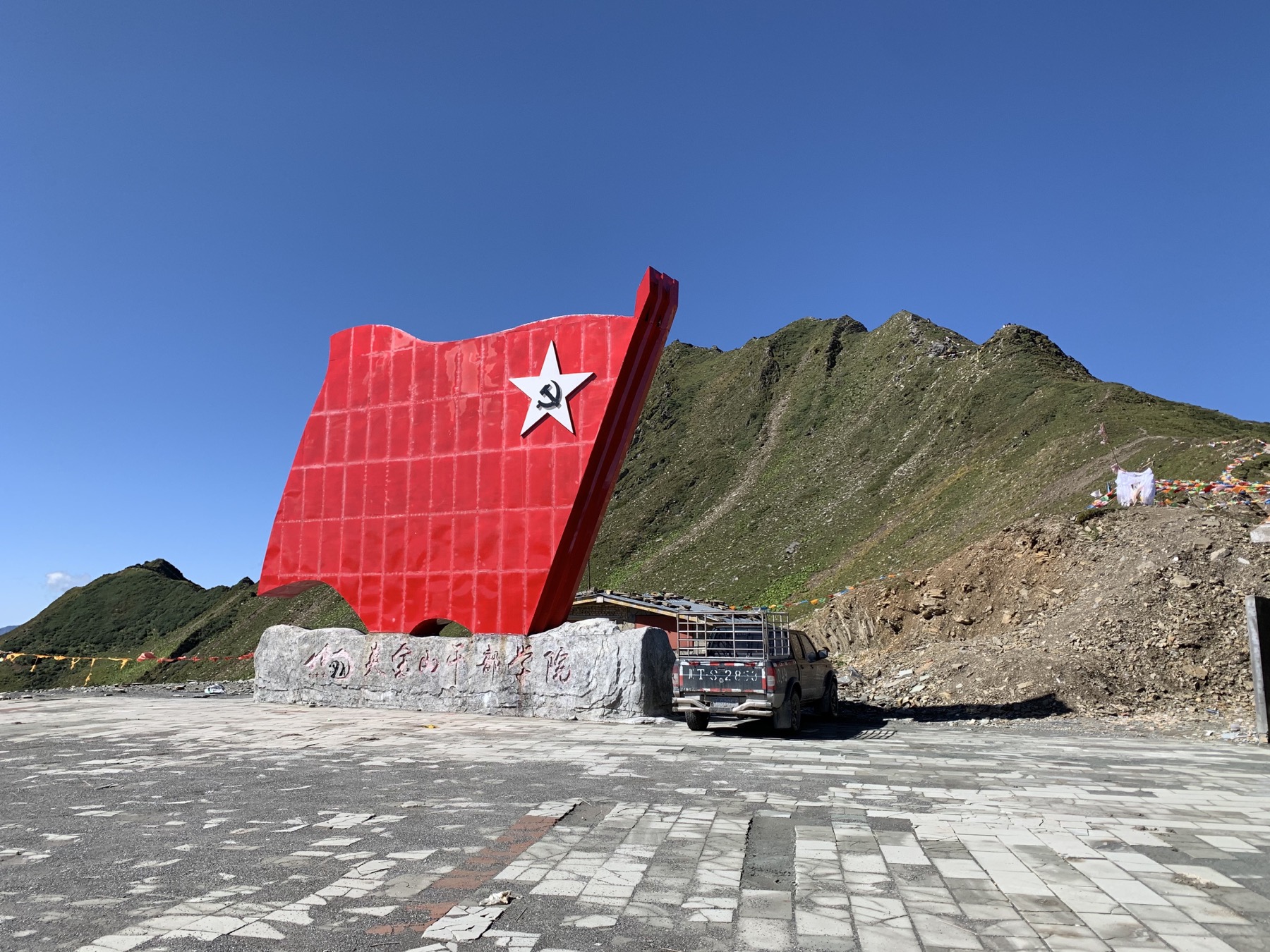

Panda priests and red pilgrims
Sichuan-Gansu-Shaanxi
Last summer, I retraced the Long March, a strategic retreat undertaken by the Chinese Communist Party from October 1934 to October 1935. I encountered caves turned into “red” tourist sites and all kinds of treacherous terrain, attended a rural wedding and mingled with all sorts of characters, each with their ambitions and dreams.
Now I find myself surrounded by the mighty rivers and mountains of Sichuan province. I reach the Luding Bridge, constructed in 1706 during the reign of the Emperor Kāngxī 康熙, with the mighty Dadu River thundering underneath. It’s here, in May 1935, that Communist forces tried to secure a bridgehead where the bulk of the army could cross unhindered.
Had Communist forces not been able to take the village and bridge, their advance would have been stalled considerably. But what exactly happened at the Battle of Luding is heavily disputed, as are the “22 heroes of Luding,” who were turned into propaganda superstars through posters and movies that depicted them crawling over a bridge that had been set ablaze and clinging to the bare chains.
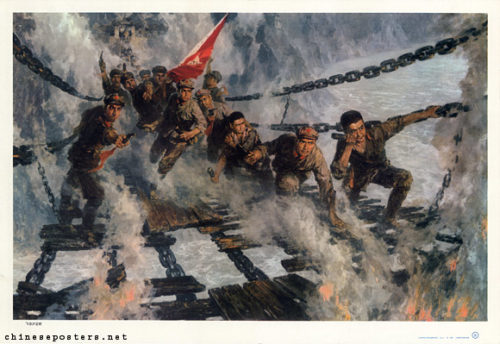
At 4 p.m. on May 24, 1935, 22 soldiers crossed the chain bridge. Simultaneously — but much less touted — a Communist force crossed the river by boat and attacked the town from the south. Accounts of the battle vary; the official PRC narrative focuses on the crossing of the chain bridge and the heroism that the soldiers displayed, while other sources claim that the Communists had brokered a deal with the warlord who held the town.
In a speech given at Stanford in 2005, Zbigniew Brzezinski, who was the National Security Advisor to President Jimmy Carter, relayed an anecdote from a meeting he had with “Chairman Dong” (the transcript of the speech only reads “Chairman Dong”; it’s possible that Brzezinski means Dǒng Bìwǔ 董必武, who had been acting chairman of the PRC from 1975 to 1978 — though it may be that there was a transcription error and “Dong” actually should be “Deng,” as in Dèng Xiǎopíng 邓小平). Brzezinski said when he praised the Luding maneuver, “Chairman Dong” smiled and replied:
“Well, that’s the way it’s presented in our propaganda. We needed that to express the fighting spirit of our forces. In fact, it was a very easy military operation. There wasn’t really much to it. The other side were just some troops of the warlord who were armed with old muskets and it really wasn’t that much of a feat, but we felt we had to dramatize it.”
Whatever the story, it remains one of the most iconic scenes on the Long March in the collective memory of a generation of Chinese citizens. Today, the Luding Bridge is still an active part of the city’s infrastructure, free of charge for locals to cross, with chain contraption.
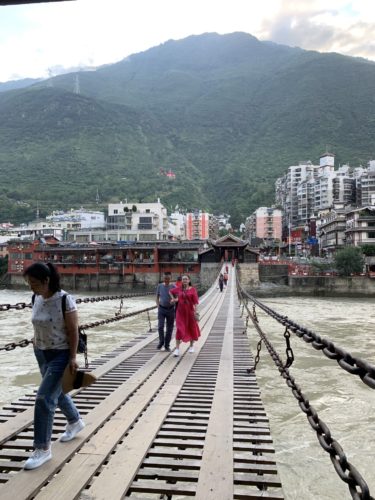
I continue via another road north toward the Jiajin Mountains, but the effects of disastrous rainfalls and flooding once again complicates my travels. The road has been cut off, and rescue workers are trying to clear villages that have endured meters of black Sichuan mudslides.
A police car cuts in front of me. Four officers jump out, one has his phone lifted up and pointed straight at me, recording the scene. “You can’t go any farther, it is not safe.”
“I am following the Long March,” I tell them. “I’m on my way over the snow-capped mountains.”
They register my passport before holding firm: I have to turn back.
I sleep under an abandoned gas station with three young Chinese bicyclists who met on an online forum. The next day I chance upon one of the only wooden Catholic churches in China. Its pastor, Father Chen, generously treats me to Sichuan delicacies with members of his congregation. Everything is organic and homegrown, cooked over a traditional wood-fired stove.
“There are two questions that our Party has not yet answered,” Father Chen smiles. “Where we come from and where we are going!” He places dishes on the table. The food was all grown in the rich soil of the Sichuan mountainside, and it is the freshest and most tasteful Sichuanese dining experience I have ever had.

Chen shows me his pastor certificate, ordained by Pope Francis, to this mountainous region of Sichuan, where the Catholic missionary Father Armand David established his mission in the mid-1800s. Father David was the first person to conduct natural scientific studies of the panda, publishing his findings in 1869. To this day, the panda still holds the scientific name that Father David devised while in the mountains of Sichuan: Ailuropoda melanoleuca — from Latin, the “mushroom bear.”
We drink the local liquor with honey. As a Party member and pastor, you are allowed to drink, because alcohol is seen as a part of Chinese culture.

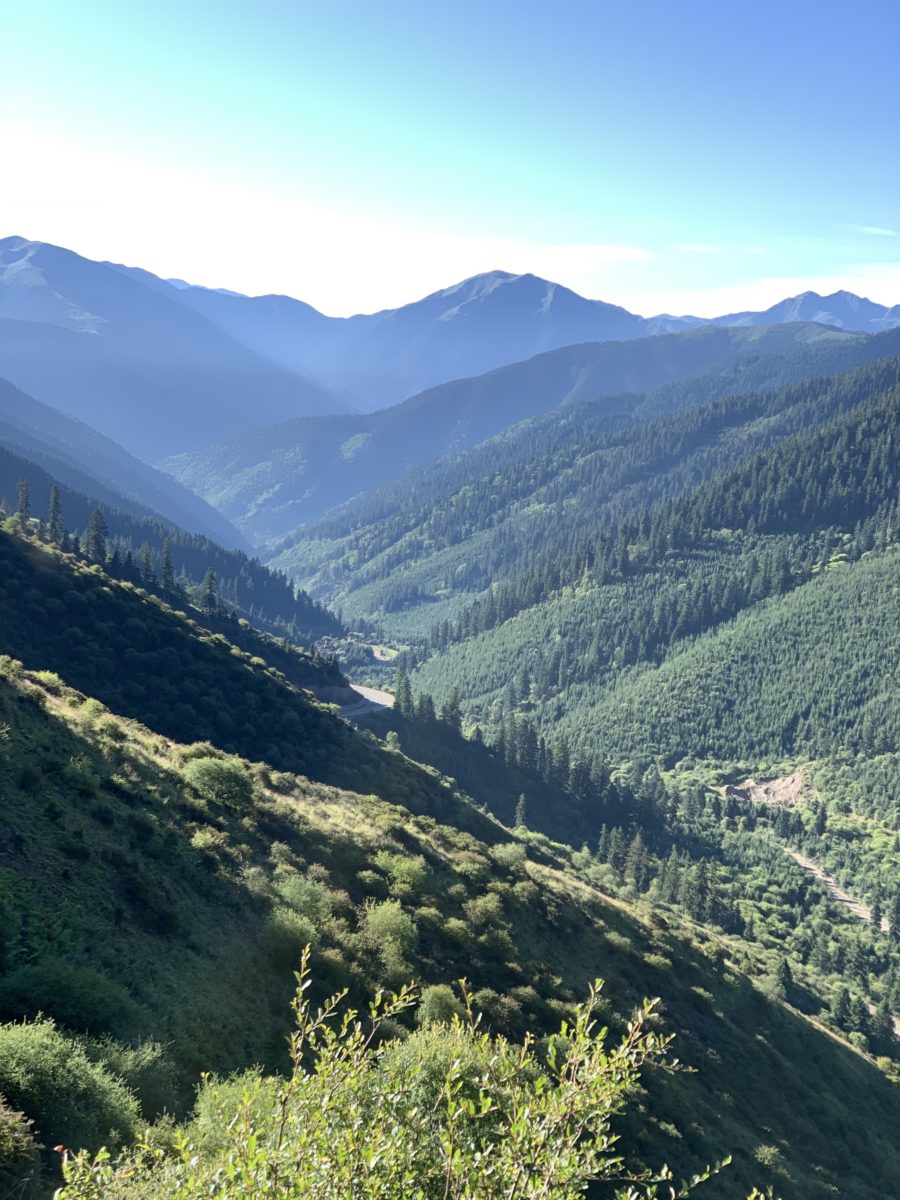
I cross the mountain the next day. It is not snow-covered in late summer, in stark contrast to when the Communists moved through here. I pitch my tent close to the top, at 4,111 meters.
On the other side of the mountain is the Tibetan Ngawa region. Rivers cut into valleys and villages fortify the points where several rivers meet — vital crossings for centuries, where roads go in different directions. The landscape rises again, and soon I find myself in the grasslands of the Tibetan Plateau in northern Sichuan, where yaks and Tibetan shepherds populate the vast expanses at about 3,500 meters.
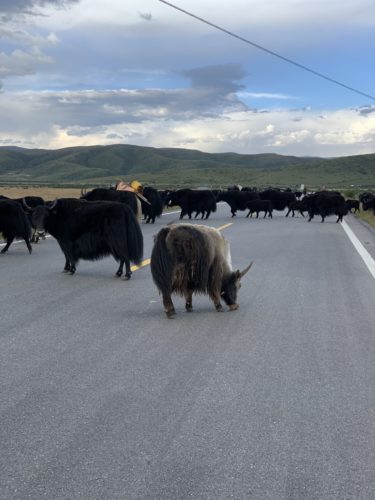
In the area of Songpan, also located in the Tibetan areas, Mao’s forces linked up with another group led by Zhāng Guótāo 张国焘, and another struggle for leadership ensued. Zhang’s forces outnumbered Mao’s, and in the heat of the Long March, military strength counted as much as internal hierarchy and prestige within the Party. Zhang wanted to take the Party west, to Tibet, and opposed Mao’s plan of heading north to Shaanxi. (More about this later.)
I follow the route into the highland steppes of northern Sichuan, where the Long Marchers crossed a marshy Tibetan grasslands. A monument stands here, commemorating those who traversed this part of the route in 1935 — and those who died on the grasslands. Great herds of yak roam, and the staple food is Tibetan tsampa barley with big boiled chunks of knife-cut yak meat.
I meet a “red” livestreamer who has spent the last year pushing a small cart, converted from a three-wheel motorized vehicle, that includes a sleeping cabin and all his belongings. He is trekking the entirety of the Long March route funded by his followers on Douyin (better known in the West as TikTok).
“Look here! Chairman Mao had to wander across this dangerous landscape.” The livestreamer pans his phone across the grasslands. “Oh thank you. Thank you all, my friends!” He has 20,000 fans, which may sound like a lot, but actually isn’t. He has a group of dedicated fans — about 50 — who give him most of the donations that keep his pilgrimage going.
He sold his kiosk in the Shaanxi city of Ankang 10 months prior and has been on this trek ever since. “Say hello to our foreign friend!” I am good content, and the questions start to roll in from his viewers all across China. “Does handsome guy need a girlfriend?” “Will we see you again on the trip?” The livestreamer is wearing a blue uniform dirty and beaten from close to a year on the road.
“I wanted to walk the Long March to transform myself,” he says. He makes no mention of whether he has felt a transformation or not, but his pilgrimage reminds me of the Tibetan and Daoist pilgrims revered throughout Chinese history who had the exact same goal of self-transformation through traveling.
I continue to the ruins of a temple at Baxi, close to Jiuzhaigou National Park, where Mao and Zhang Guotao met before the battle of Baozuo.

Baozuo was a transport junction in the difficult mountainous terrain of northern Sichuan. Nationalist commanders had placed a strike army here, ready to harass the Communist forces as they moved north. A decision was made by the leadership to engage in a head-on battle with the Nationalists.
The Nationalists was caught by surprise and here, in the picturesque alpine landscape that looks like a scene right out of The Sound of Music (with Tibetan shrines and villages instead of European architecture), Nationalist and Communist forces engaged in ruthless hand-to-hand combat, using rifles, machine guns, and pistols, as well as bayonets, broadswords, clubs, and knives.
The combined Communist forces emerged victorious. Afterwards, Mao and Zhang convened the Baxi Conference, which was the last meeting between the two before their forces split up. Zhang marched south before moving west toward Tibet, while Mao continued north toward Yan’an. The fight at Baozuo was the Communists’ last major engagement with Nationalist forces.
I drive through the beautiful blue and green valleys. Because of heavy rains, I am forced to seek refuge in a Tibetan teahouse, where the manager lets me spend the night on a sofa.
Further flooding to the north forces me to veer off course for a while, before I pick up the route again through Gansu and into Shaanxi. The cities and villages here are all built along the rivers and mountains, where catastrophes are a poignant reminder of the way that communities have struggled with the forces of nature for centuries.

The mountains turn to hills, the dirt turns yellow — part of the yellow earth that characterizes the lands along the Yellow River. In Shaanxi, the hills are terraced, and some traditional cave dwellings can still be found.

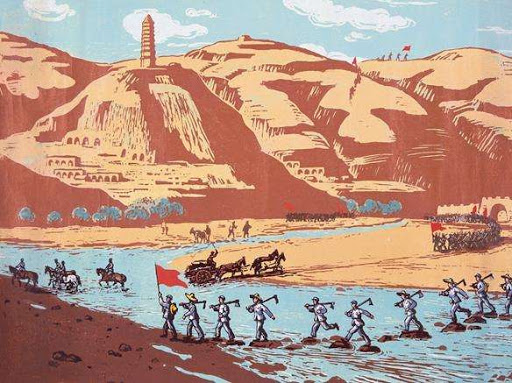

I reach Yan’an after 25 days on the road. The gauge on my Suzuki GN125 motorbike reads 6,476 kilometers.
In Yan’an, the Long March ended, and the CCP leadership established a base that would become synonymous with the Party’s struggle. This is where Mao formulated many of the texts that form the basis for Party curriculum today.
Zhang Guotao’s forces staggered into Yan’an after being mauled by the Ma clique, a family of powerful warlords who controlled the west for a decade. Having abandoned his plans to set up a base area out west, Zhang — the last true threat to Mao’s rule — entered Yan’an with a weakened army that was now outnumbered by Mao’s.
Zhang stayed in Yan’an before defecting in 1938. He was intercepted in Xi’an by Communist agents who allegedly gave him the choice of returning to Yan’an or renouncing his Party membership for good. He chose the latter and fled into exile, living out the rest of his days in Canada, where he died in 1979.
With Zhang Guotao gone, Mao had free rein to solidify his power. In 1936, the American journalist Edgar Snow met Mao in Yan’an, where he got what would be the first cohesive account of the Communist Party and “the Long March.” Mao’s old cave dwelling, where he met Snow, can still be found in Yan’an. The city is a red tourist haven, with Party members and patriots flocking here to see where the country’s early leaders planned the next step of the revolution.
“Have you arrived?” the red instructor from Ruijin, Jiangxi — where I began my journey nearly a month ago — asks over WeChat. He sends a list of all the sites that I need to see while I’m here.
“I’ve gotten hold of the central government, they think the cave meets the requirements for a red tourist area,” Mr. Liu, who runs a “red cave” that I visited near the beginning of my trip, tells me.
“Send a video of yourself — then I’ll send it to my fans!” the livestreamer says. He was still on the road when I left Yan’an, but he arrived two months later. After returning to Ankang in southern Shanxi, he has attempted to start an influencer career, not quite earning the title of local celebrity, but advertising local rice, berries, river fish, and nuts on his account.
As for me, my journey is over. Following the Long March route was one of the most epic journeys I’ve ever undertaken. (Also see: Road-tripping through fear, rumors, and a virus-stricken China.) The road through China’s heartland showed that the symbolism of the Long March is as important as ever, and that the stories from the march — all the narratives and counter-narratives — survive to this day as a central part of Chinese Communist Party mythos.
This is Part 3 of 3 of Mads Vesterager Nielsen’s motorbike trip along the Long March route. Parts 1 and 2 are below:
